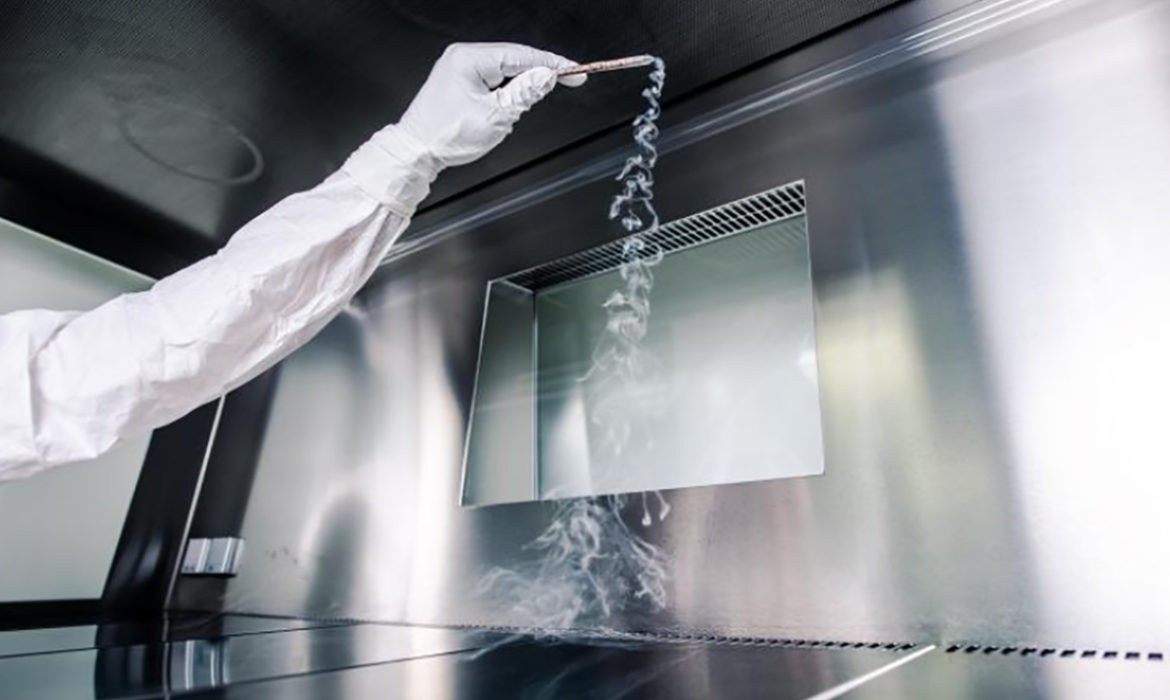Focus on the “Smoke test”
Introduction to the smoke study
Critical manufacturing increasingly frequently requires high quality standards and constant repeatability. For many years now, a multitude of manufacturing processes have taken place in controlled-contamination areas, which vary in terms of size, type and personnel and product safety levels. Their design is based on the level of criticality of the manufacturing or analysis operations for which they were conceived. These are dynamic environments whose operational efficacy depends primarily on the constant balance of different variables, in which air is usually the main control and operation fluid.
The main critical parameters to be monitored to ensure an optimum operation of controlled-contamination areas include analysing the trend of the airflows and process equipment inside the areas. Treated airflows are a fundamental means for protecting critical process environments if appropriately managed and controlled. The smoke study design phase is fundamental for objectively and rationally establishing the objectives to be achieved by observing flows, given their considerable applicability.
The importance of the smoke study
The smoke study is a technique for qualitatively analysing an airflow and consists in injecting into it a tracer (visible to the naked eye) that enables adequate visualisation of the airflows in and around the manufacturing processes to which it is applied. Many tracer generators are available on the market and those most commonly used are based on the production of aerosol from purified water by means of ultrasonic processes or liquid nitrogen exchangers.
The use of this process offers considerable advantages for characterising the airflows of processing areas and the corresponding environments. More specifically, a well-structured process is able to objectively demonstrate the particular aeraulic characteristics of manufacturing environments in order to identify flow trends suitable for protecting processing areas depending on their criticality status.
This type of analysis can be transversally applied to many productive sectors, most notably:
- pharmaceutical companies
- hospitals
- advanced therapies
- aerospace industry
- semiconductor industry
- analysis industry
The tracer
In order to obtain effective results in the analysis of airflows inside controlled-contamination areas, it is fundamentally important that the tracer used has specific characteristics.
More specifically, the tracer must have a high volatility factor so that it can be readily transported by the airflow without influencing its motion, which would significantly compromise the outcome of the study. In these cases, the tracer could follow a downward direction from the mouth of the generator, and prevent a clear view of the stagnant airflows in certain parts of the process. This could lead to distorted results and the failure to identify critical problems within the system.
The effectiveness of the tracer depends on its persistence and visibility, which make it possible to avoid altering the background and to show the characteristics of the airflow clearly. It is important to minimise external intervention during the smoke study and to use a non-toxic and non-corrosive tracer. In addition, the relative humidity of the air must be adequate, in order to obtain proper saturation.
Airflow visualisation
The smoke study can be carried out under “at-rest” and “operational” system conditions. It aims to pinpoint the potential sources of contamination within the manufacturing process and the corresponding environment. These sources can be the result of poor critical area design or inadequate flow management by the ventilation system. Airflow visualisation makes it possible to identify the areas at risk, supports the definition of corrective actions and rates their effectiveness after implementation.
The result of the study may vary depending on the cleanliness of the area and the particular characteristics of the system: in confined areas with one-way flow, the air movement analysis should show one-way flows and the system’s ability to protect the product and critical areas properly. This result is obtained by constant washing with primary air originating from absolute filters, which guarantees the removal of undesirable particulate from the environment.
The main benefits of the smoke study
In addition to being effectively used in the objective analysis of the main and secondary process phases, the smoke study is a useful aid for assessing process layout changes and improvements, by identifying corrective actions.
Inside controlled-contamination areas, the smoke study can be useful for testing pressure cascades towards the surrounding areas and less critical rooms.
This type of analysis has vast applications for the definition of process and set-up operating procedures and can be helpful for training specialised personnel who have to work in a controlled-contamination area.
Lastly, use of the smoke study is an opportunity to give a high added value to the process analysed, thereby improving its quality standards and significantly reducing the risks of possible failures that could have indirect effects on product quality.




